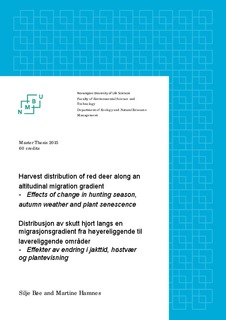| dc.description.abstract | Many ungulates perform seasonal migration by moving between high-elevation summer ranges and low-elevation winter ranges. While areas at high elevations often yield high-quality forage during summer, such altitudes may provide harsh winter conditions. Animals may therefore depend on environmental cues, such as temperature, snow depth and plant quality to determine timing of migration. Because management units are often too small to capture the whole migration routes of large ungulates, and because of the spatiotemporal variation in animal abundance caused by migration, there may be an unfair distribution of hunting revenue and cost among different landowners. A way to even the revenue from hunting among landowners can be to adjust the timing of hunting season to better capture animal movements. As an attempt to harvest a higher proportion of red deer in summer areas, the hunting season of Norwegian red deer was advanced from 10th September to 1st September in 2012.
In this master thesis we analysed harvest data from 2000-2013 on red deer before and after the change of the hunting season, together with data on temperature, snow and plant senescence. Our aim was to identify factors that affected the annual variation in the number of harvested red deer per municipality and year, along an altitudinal migration gradient in the core area of red deer distribution in Norway. We were especially interested in finding the effect of the hunting season change.
We found that by moving the start of the red deer hunting season, the proportion of animals harvested at higher elevations increased by ~7 %. The effect found was relatively small, but matched the proportion of individuals migrating between 1st and 10th September. By allowing hunters to begin harvesting earlier, hunters at higher elevations are able to harvest the animals that spend the summer in their areas before they migrate to lower elevations. This means that the hunters are able to benefit from the same animals that potentially cause grazing damage on agricultural areas during summer. The distribution of harvested red deer along the elevation gradient was not affected by variation in autumn weather and plant senescence in a way that reflected migratory behaviour. Our study provides evidence that changing the timing of the hunting season is an efficient management tool to redistribute hunting revenue along an altitudinal migration gradient, and gives insight to the effect of a management decision made to even the cost and benefits of a migratory ungulate. | nb_NO |
